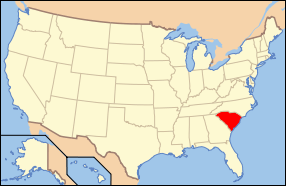Brick House Ruins
|
Brick House Ruin | |
|
Paul Hamilton House (Brick House Ruins) | |
  | |
| Nearest city | Edisto Island, South Carolina |
|---|---|
| Coordinates | 32°36′5.3″N 80°19′31.5″W / 32.601472°N 80.325417°WCoordinates: 32°36′5.3″N 80°19′31.5″W / 32.601472°N 80.325417°W |
| Area | 0.3 acres (0.12 ha) |
| Built | 1725 |
| Architectural style | American colonial with French Huguenot influence[1] |
| NRHP Reference # | 70000580[2] |
| Significant dates | |
| Added to NRHP | April 15, 1970[1][2] |
| Designated NHL | April 15, 1970[1] |
The Paul Hamilton House, commonly referred to as the Brick House Ruins, is the ruin of a 1725 plantation house on Edisto Island, South Carolina, that burned in 1929. It was designated a National Historic Landmark in 1970 for the unusual architecture of the surviving walls, which is based on part on French Huguenot architecture of the period.[3]
Construction
The house was constructed about 1725 for Paul Hamilton, a wealthy South Carolina planter, on Edisto Island, one of the Sea Islands in what was then the Province of South Carolina.[1]
Materials
The two-story house was constructed with exterior walls of brick imported from Boston, such brick being harder and denser than the local kind. The interior of the home was primarily constructed of locally produced lumber which had been aged seven years. Construction also utilized local gravel and sand brought to the site from the Pon Pon.[4]
Architecture
Its architectural design is in keeping with American colonial architecture but exhibits French Huguenot influence.[1] Possibly a simplified copy of the c. 1675 Chateau de la Haye d'Esquermes near Loos les Lille, France, evidence of the French influence in its architecture is seen through many stucco enrichments to the exterior and its high-pitched roof.[4]
History
It served as the plantation house for a 300-acre (120 ha) plantation.[1] The estate was acquired in 1798 by the Jenkins family which maintains ownership to this day.
In 1929 the house caught fire, with its wooden portion being largely reduced to ashes and only its brick walls with stuccoed quoins and trim remaining.[3] Until that time, it had not been significantly altered.
The ruin was recorded photographically as part of the Historic American Buildings Survey of the National Park Service cataloged at the Library of Congress in both 1936 and 1939.[3][5]
It was declared a National Historic Landmark and added to the National Register of Historic Places on 15 April 1970.[1]
The South Carolina Department of Archives and History published a summary of the site as a part of South Carolina history.[4] They describe it as an artifact of important early French influence in the Carolinas, considered a "stately and picturesque ruin in its own right." They cite the architecture of the outer walls as being "unique in this country."[4]
Currently
Following the fire of 1929, some stabilization was performed. Metal supports were used to brace some openings, but their expansion over time has actually damaged some of the material. In addition, the two chimneys (shown in the main photo above) had their top portions removed to prevent their damaging the walls in case of collapse. As of February 2013, the shell still stands, but the National Park Service considers it to be in an "emergency" condition due to major cracks and deformation of the south wall, with collapse likely if no remedial action is taken.[6]
See also
- List of National Historic Landmarks in South Carolina
- National Register of Historic Places in Charleston County, South Carolina
References
- 1 2 3 4 5 6 7 "Brick House Ruin". National Historic Landmark summary listing. National Park Service. Retrieved 2008-02-16.
- 1 2 National Park Service (2010-07-09). "National Register Information System". National Register of Historic Places. National Park Service.
- 1 2 3 "Brick House Ruins nomination form" (pdf). National Register of Historic Places. National Park Service. Retrieved 2009-01-09.
- 1 2 3 4 "Brick House Ruins, Charleston County (Edisto Island)". National Register Properties in South Carolina listing. South Carolina Department of Archives and History. Retrieved 2008-03-18.
- ↑ "Brick House Ruins" (pdf). Photographs. National Park Service. Retrieved 25 May 2012.
- ↑ Robert Behre (Feb 11, 2013). "Brick House not as solid as its name implies". Charleston Post & Courier. Retrieved Feb 11, 2013.
External links
-
 Media related to Brick House Ruins at Wikimedia Commons
Media related to Brick House Ruins at Wikimedia Commons - Brick House Ruins, Charleston County (Edisto Island), at South Carolina Department of Archives and History
- Application for placement on the National Register of Historic Places on file with the South Carolina Department of Archives and History
- Historic American Buildings Survey (HABS) No. SC-1, "Paul Hamilton House (Ruins), Russell Creek, Edisto Island, Charleston County, SC", 10 photos, 9 measured drawings, 6 data pages
.jpg)

